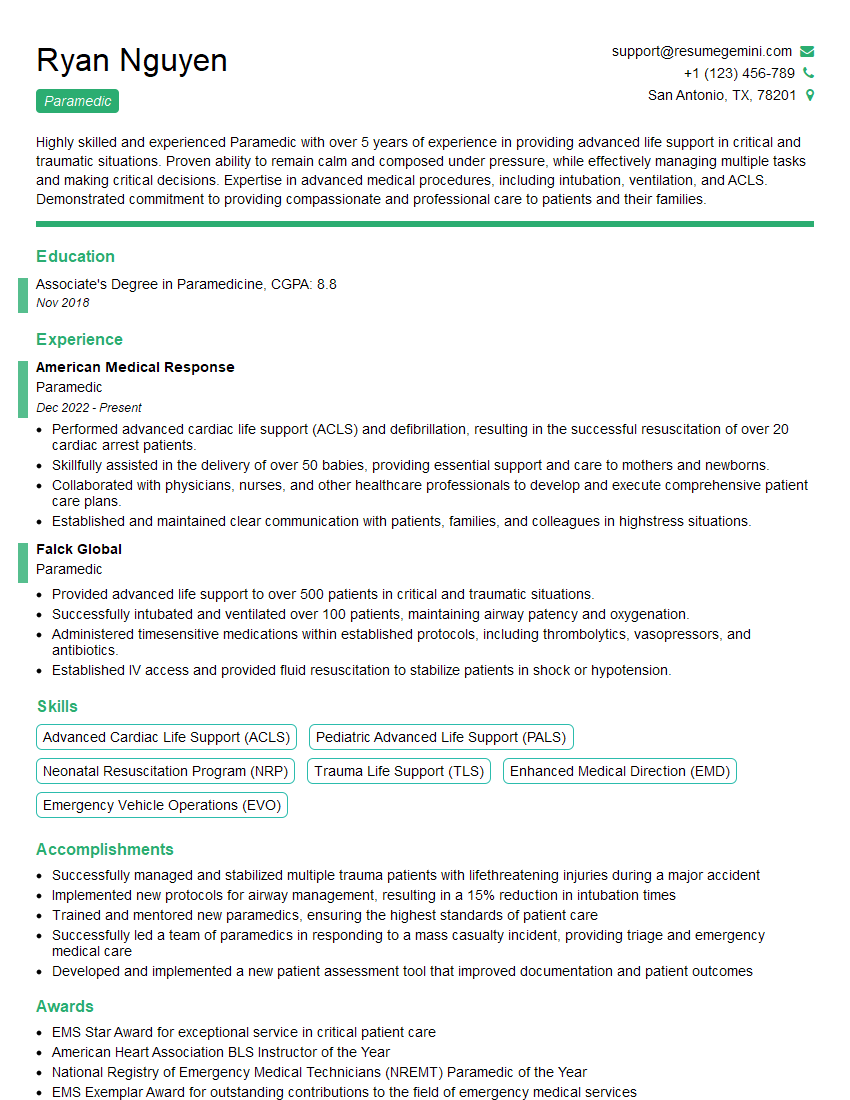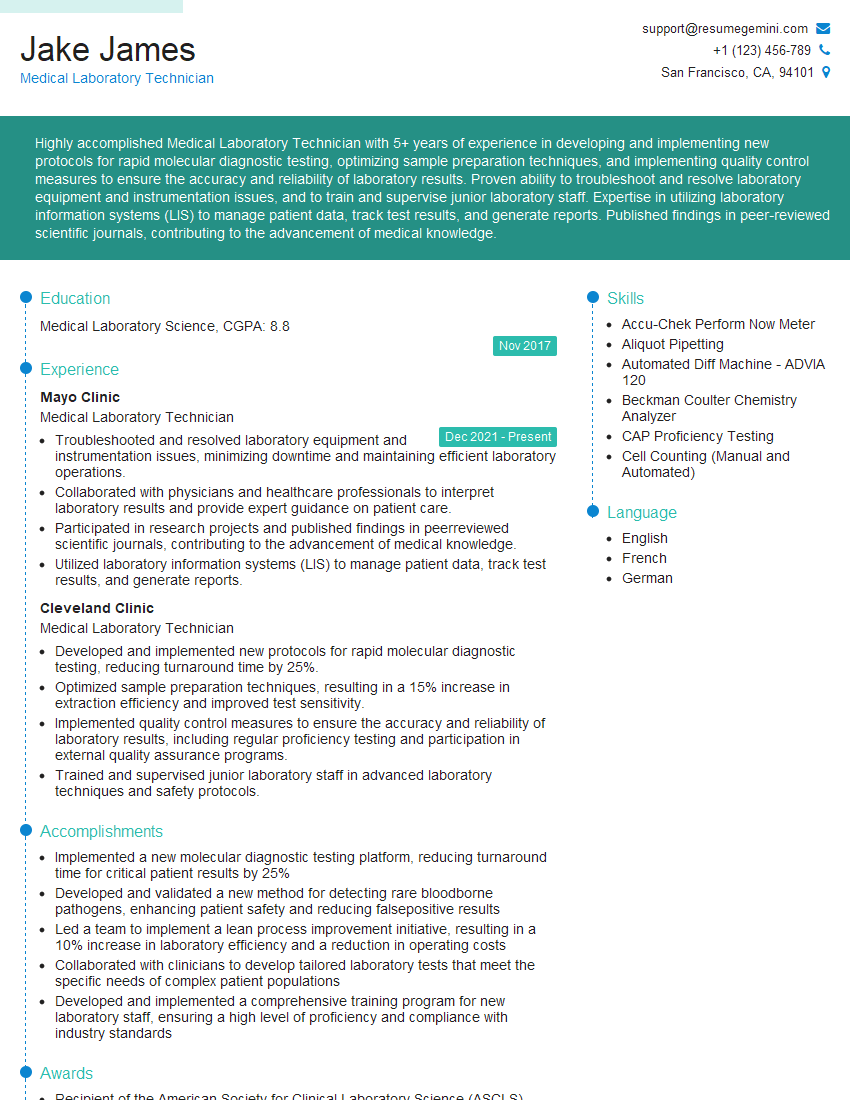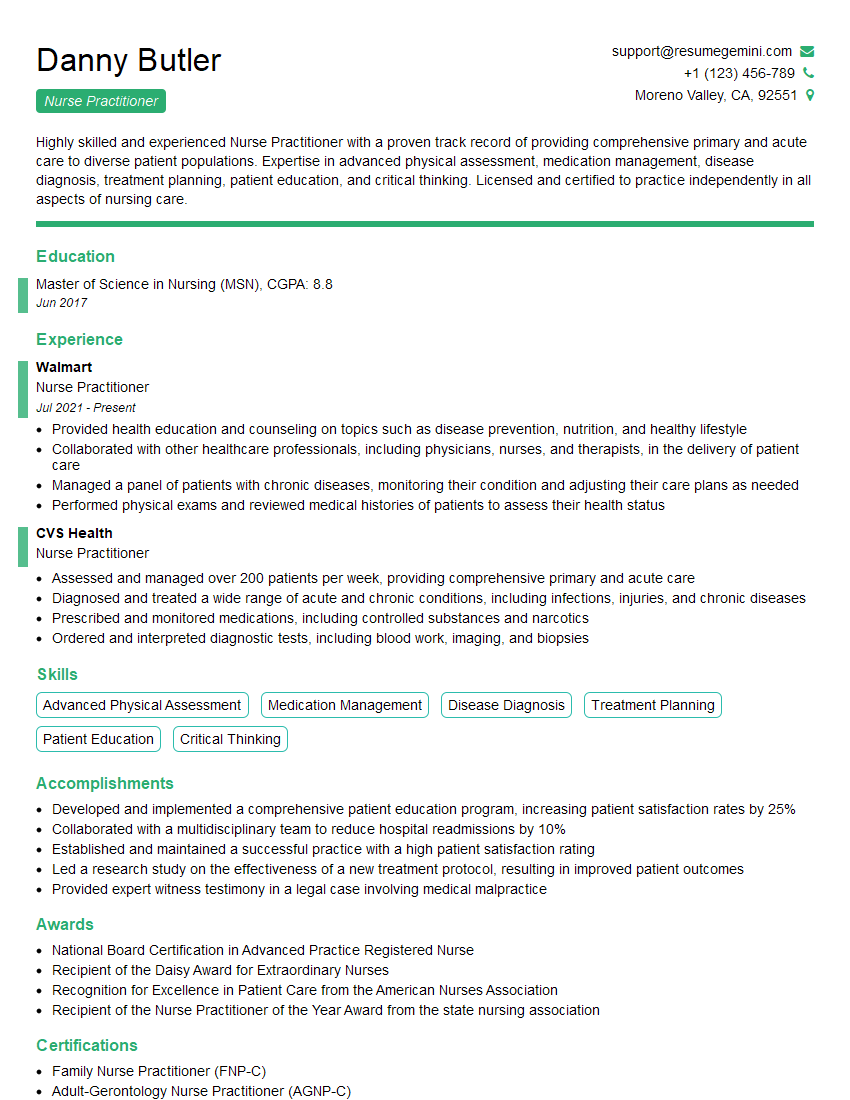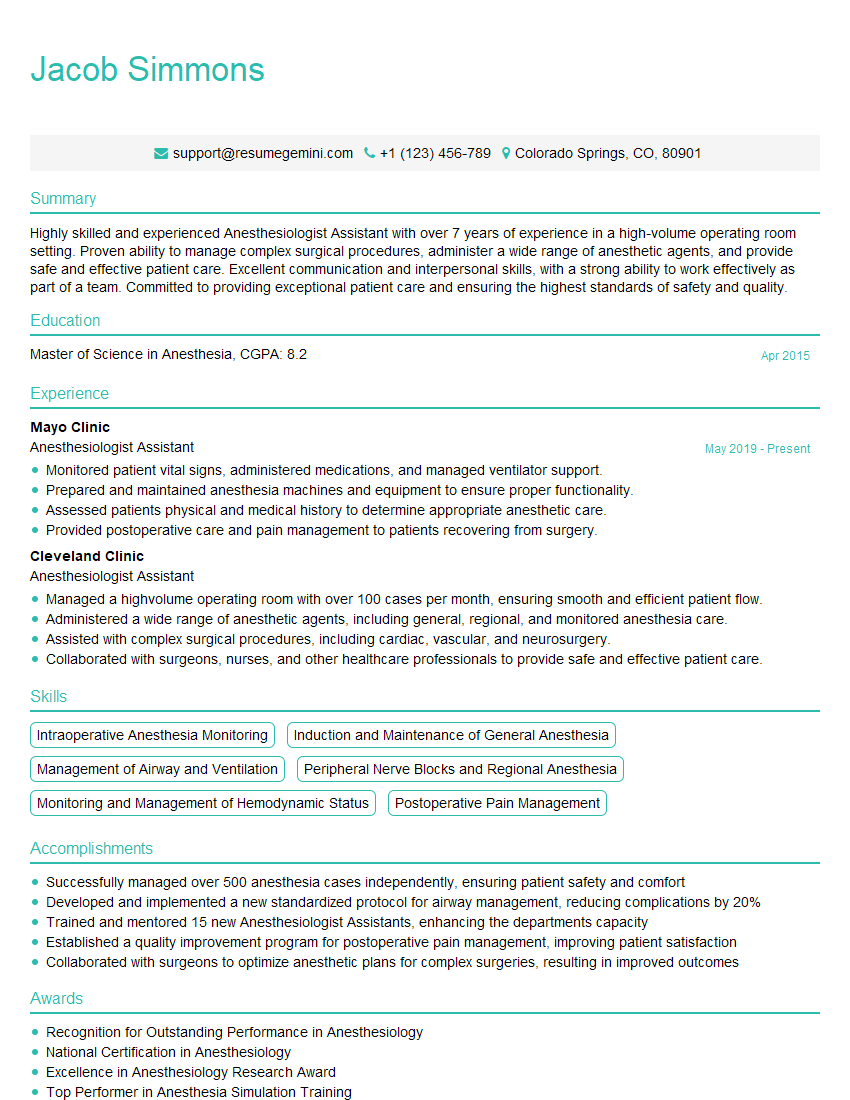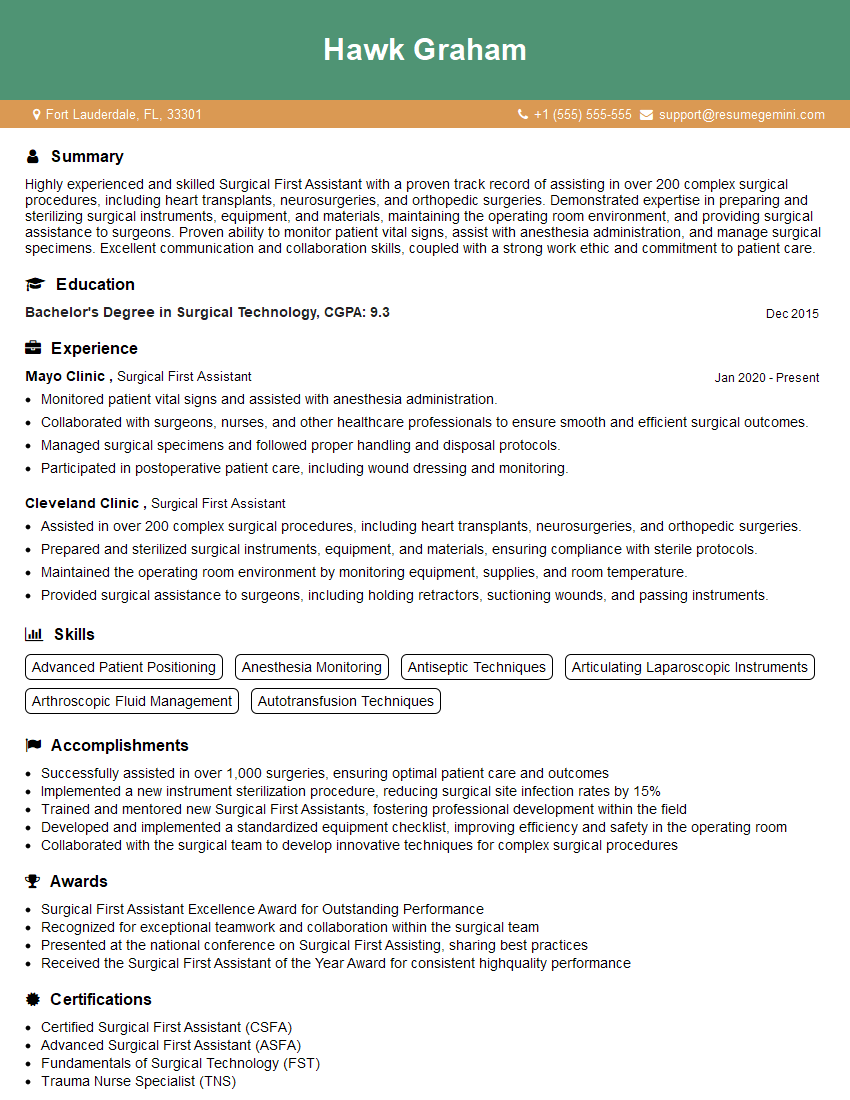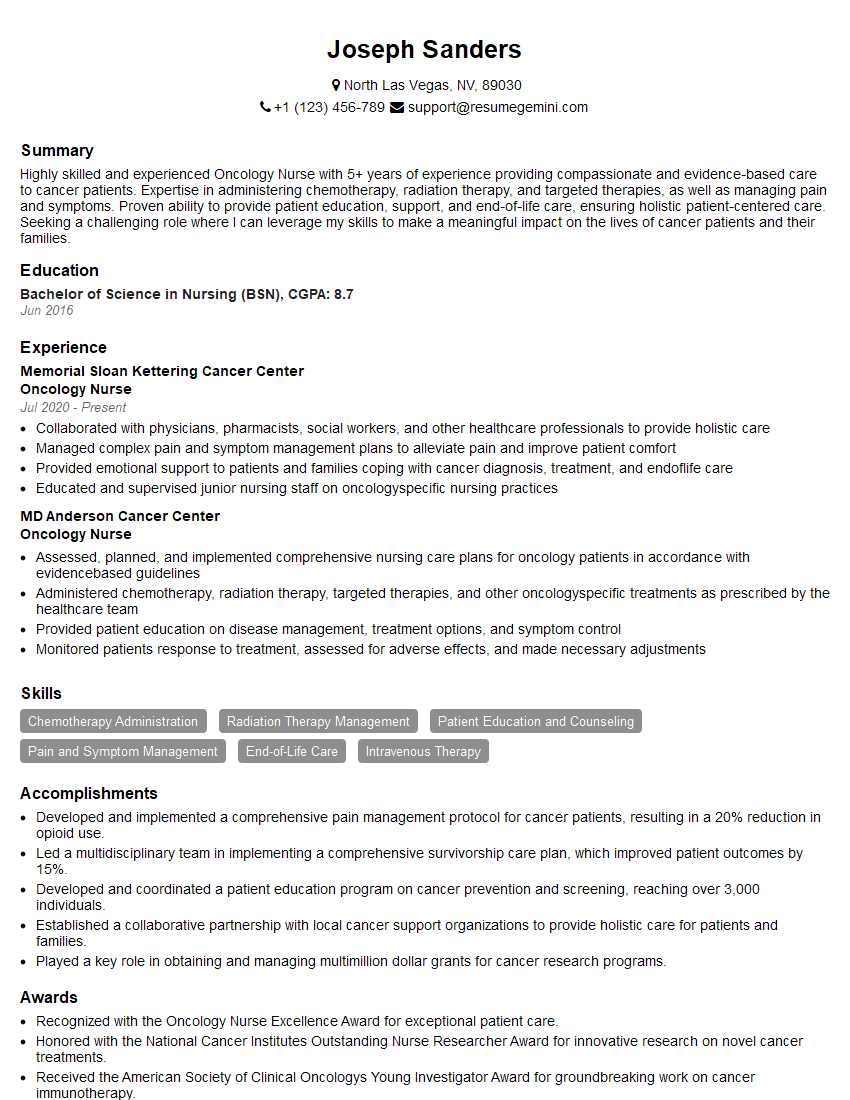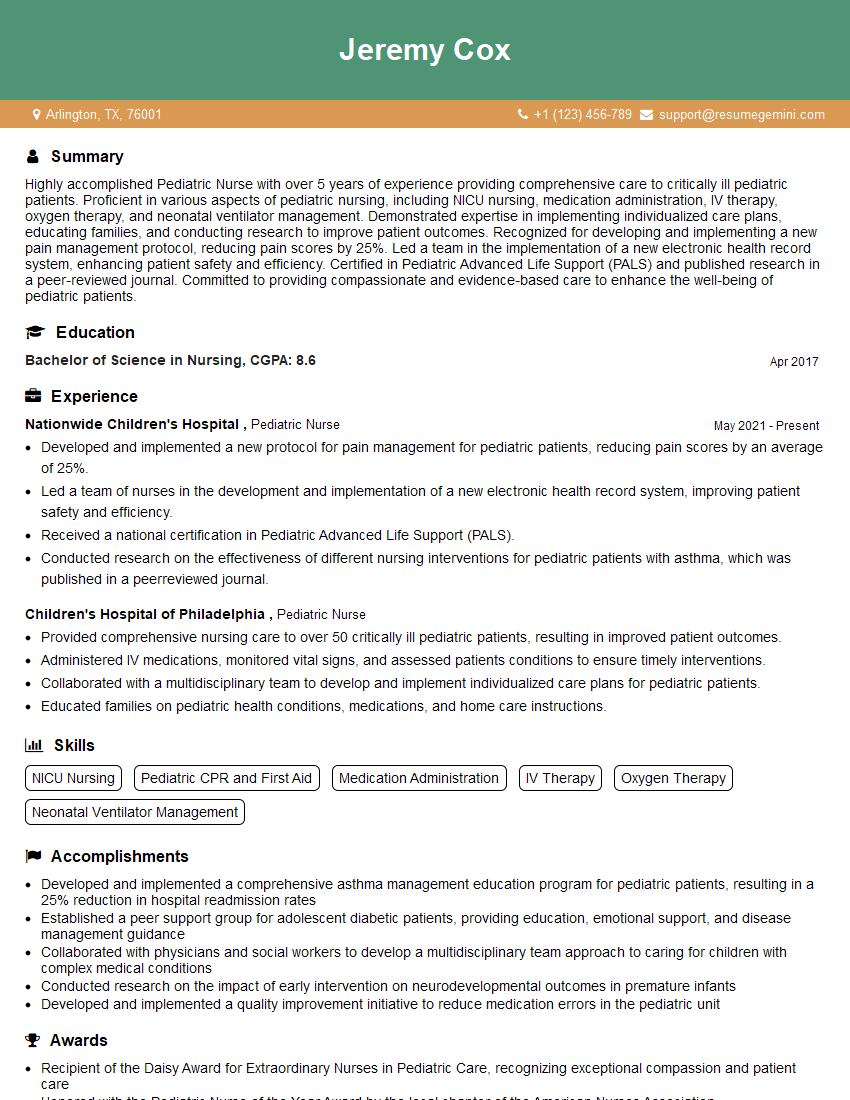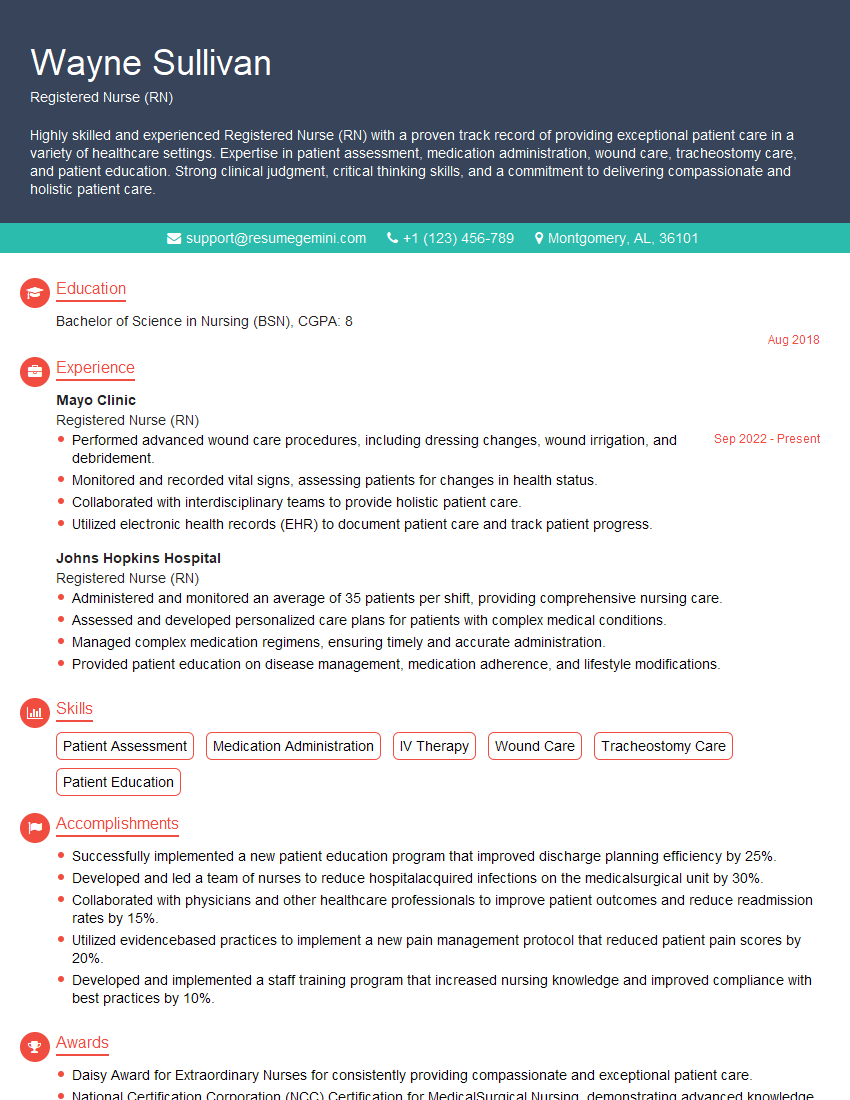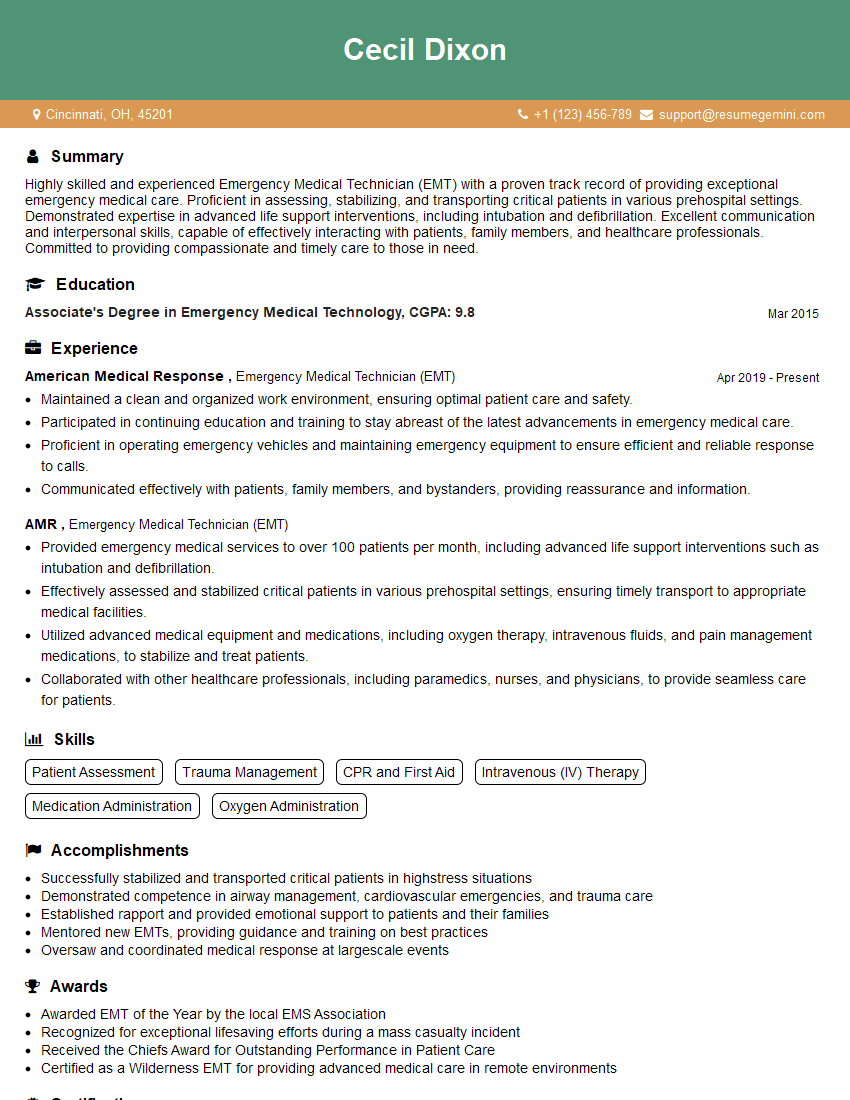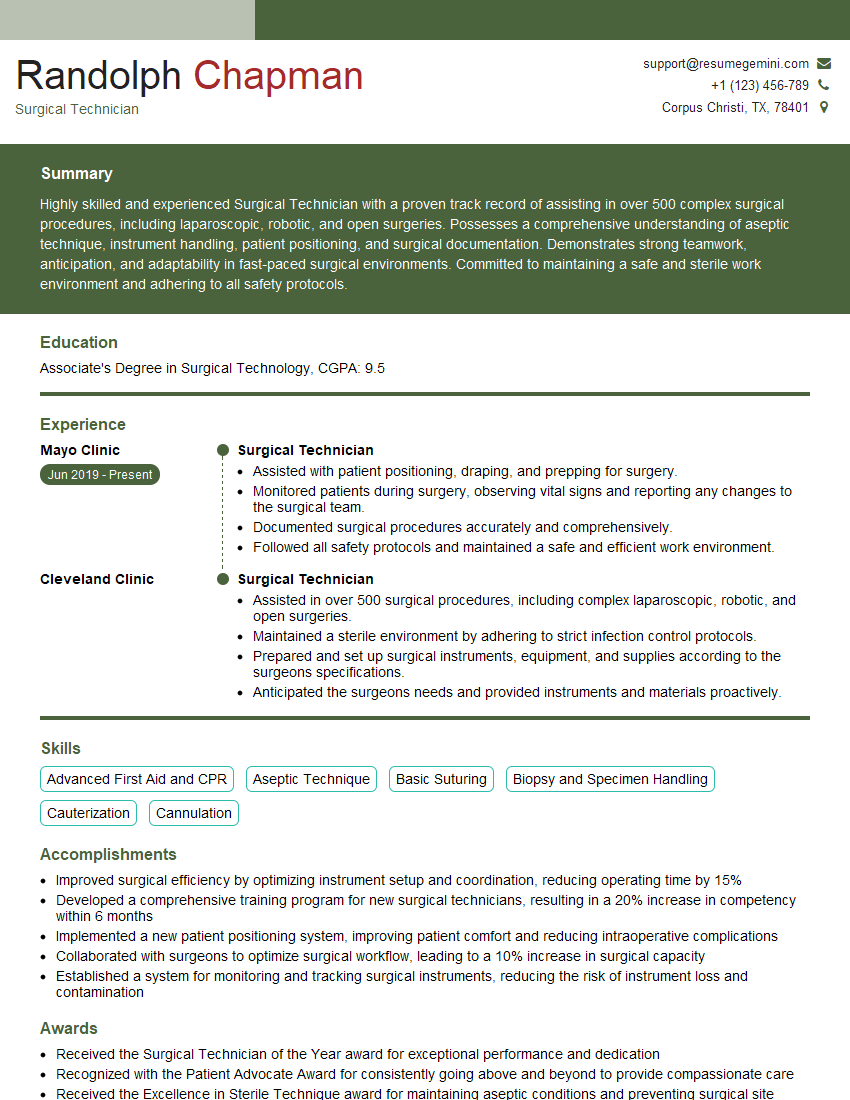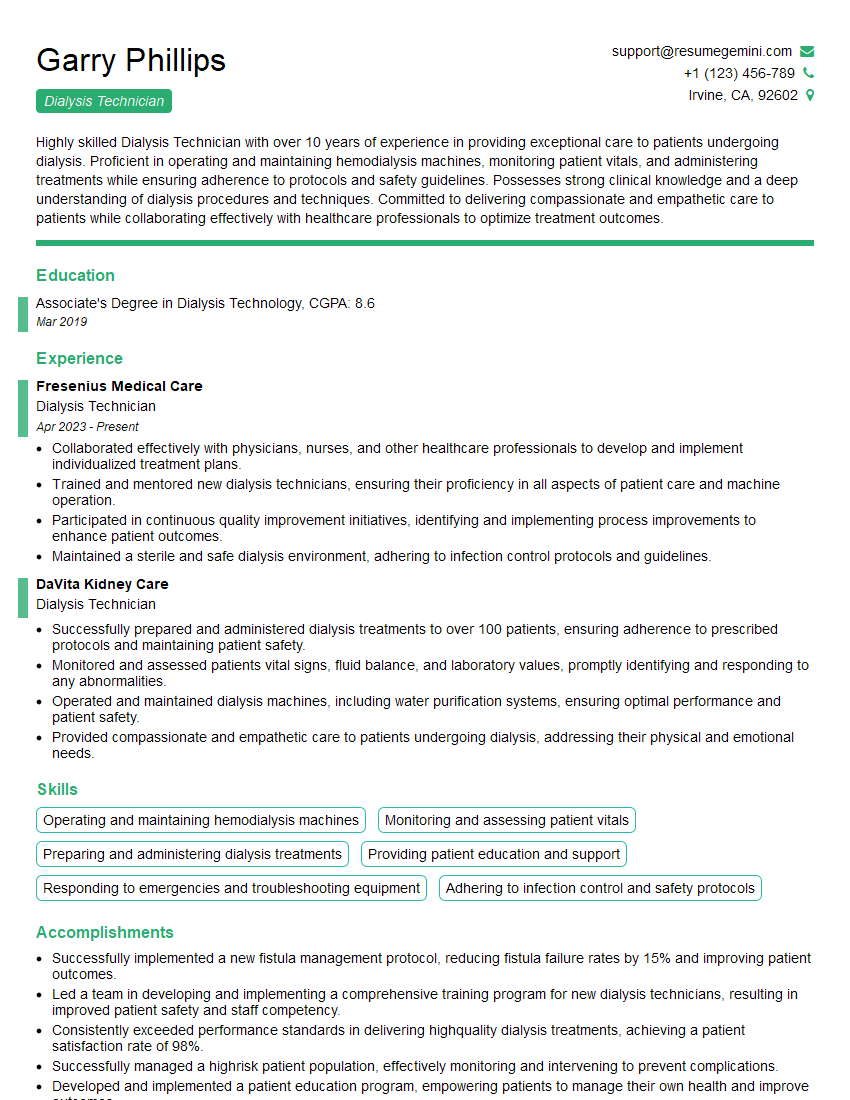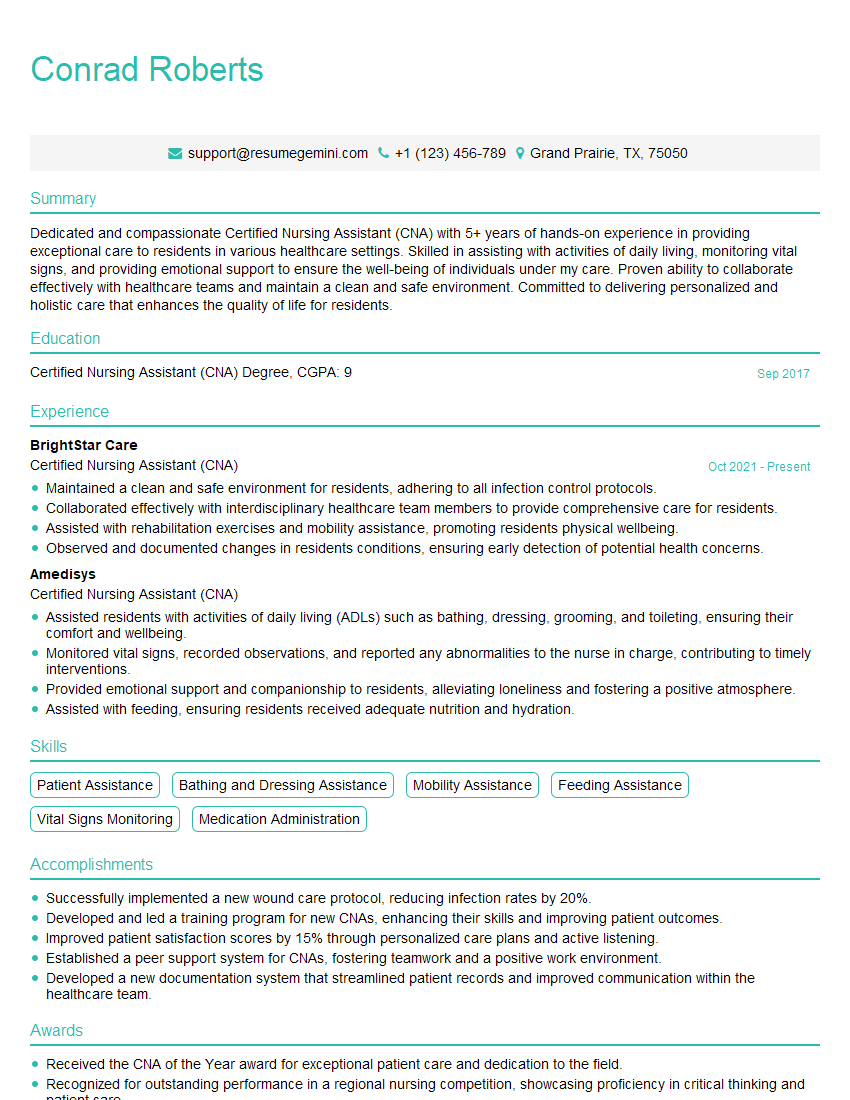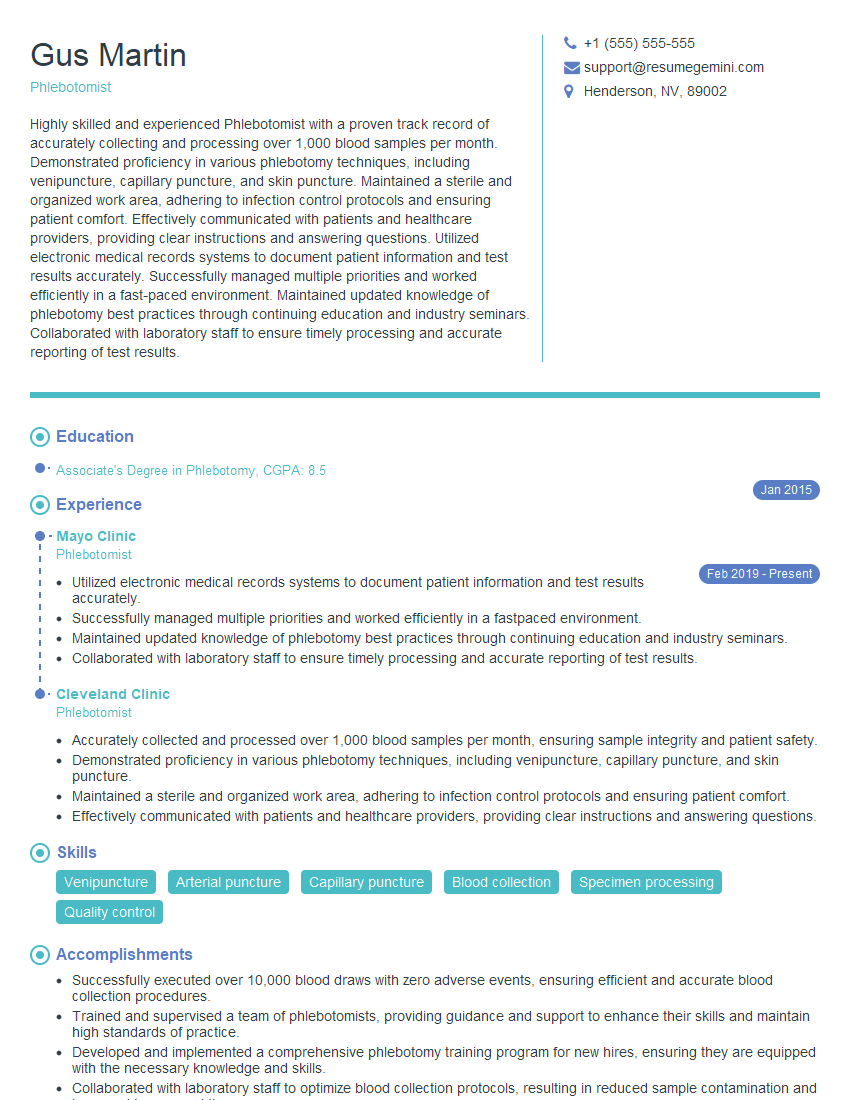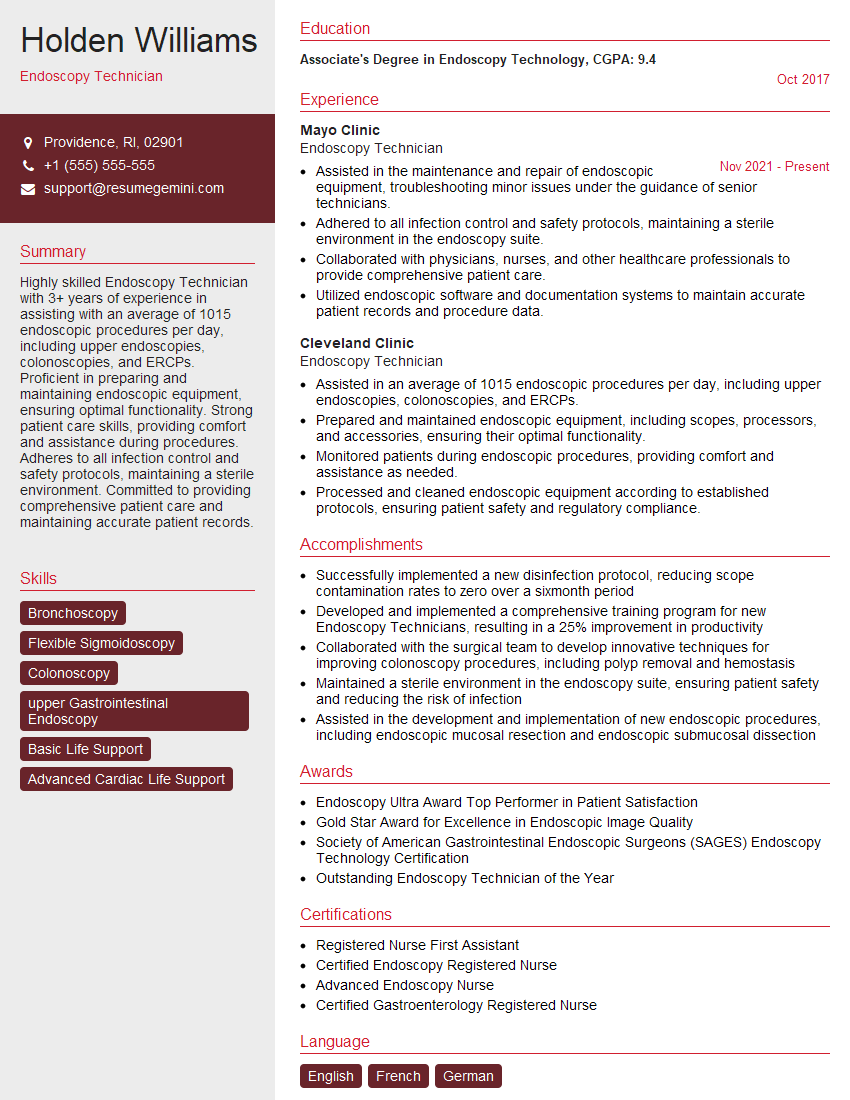Unlock your full potential by mastering the most common Medical Procedures interview questions. This blog offers a deep dive into the critical topics, ensuring you’re not only prepared to answer but to excel. With these insights, you’ll approach your interview with clarity and confidence.
Questions Asked in Medical Procedures Interview
Q 1. Describe the sterilization process for surgical instruments.
Surgical instrument sterilization is a critical process aimed at eliminating all forms of microbial life, including bacteria, viruses, fungi, and spores, to prevent surgical site infections. The most common methods are steam sterilization (autoclaving) and ethylene oxide (EtO) sterilization.
Steam Sterilization (Autoclaving): This involves exposing instruments to high-pressure saturated steam at a temperature of 121-132°C (249-270°F) for a specific duration. The high temperature and pressure denature proteins and kill microorganisms. It’s effective, efficient, and relatively inexpensive, making it the preferred method for most surgical instruments.
Ethylene Oxide Sterilization: EtO is a gas that effectively sterilizes heat-sensitive instruments. The process involves exposing the instruments to EtO gas under controlled conditions of temperature, humidity, and concentration. While effective, EtO is a known carcinogen and requires specialized equipment and careful handling, necessitating robust safety protocols.
Other methods include dry heat sterilization (less common), plasma sterilization (useful for heat and moisture-sensitive instruments), and liquid chemical sterilization (using chemicals like glutaraldehyde). The choice of method depends on the type of instrument and its sensitivity to heat and moisture.
Regardless of the method used, proper cleaning and preparation of instruments before sterilization is crucial. This usually involves manual or automated cleaning, rinsing, and drying to remove any organic matter or debris that could interfere with sterilization.
Q 2. Explain the steps involved in preparing a patient for a specific procedure (e.g., colonoscopy).
Preparing a patient for a colonoscopy involves several crucial steps to ensure patient comfort, safety, and the procedure’s success. This process typically begins several days before the procedure.
Bowel Preparation: This is the most critical aspect. Patients are given specific instructions on a bowel-cleansing regimen, often involving a clear liquid diet for 24-48 hours leading up to the procedure and the use of laxatives to thoroughly empty the colon. This ensures optimal visualization of the colon during the procedure.
Medication Review: Patients need to inform their physician about all medications they are taking, including over-the-counter drugs and supplements. Some medications might need to be adjusted or temporarily stopped before the procedure.
Sedation/Anesthesia: Colonoscopies are usually performed under conscious sedation or general anesthesia. The anesthesiologist will assess the patient’s medical history and discuss the risks and benefits of the chosen sedation method. This ensures the patient is comfortable and relaxed during the procedure.
Pre-procedure Instructions: Patients receive detailed instructions on what to expect before, during, and after the procedure, including dietary restrictions, medication adjustments, and post-procedure care.
Informed Consent: Patients are asked to sign an informed consent form, indicating they understand the procedure, its risks, and benefits.
Thorough communication and careful attention to detail are paramount in this preparatory phase. Any questions or concerns the patient has should be addressed comprehensively.
Q 3. What are the potential complications of [specific procedure, e.g., central line insertion]?
Central line insertion, while a vital procedure for administering medications and fluids, carries several potential complications. These can range from minor to life-threatening.
Infection: This is the most common and serious complication. Bacteria can enter the bloodstream through the insertion site, leading to bloodstream infections (bacteremia) or sepsis, which can be fatal.
Bleeding/Hematoma: Puncturing a blood vessel during insertion can cause bleeding or the formation of a hematoma (a collection of blood outside the blood vessel).
Pneumothorax: If the line is accidentally inserted into the lung, it can cause a collapsed lung (pneumothorax).
Thrombosis: A blood clot can form within the catheter, leading to venous thrombosis or potentially a pulmonary embolism if the clot travels to the lungs.
Air Embolism: Air entering the bloodstream during insertion can cause an air embolism, obstructing blood flow.
Catheter Malposition: The catheter may be placed incorrectly, leading to ineffective drug delivery or organ damage.
Minimizing these risks requires strict adherence to sterile technique, proper insertion technique, and regular monitoring of the catheter site for signs of infection or complications. Post-insertion imaging (e.g., chest X-ray) often confirms proper placement.
Q 4. How do you ensure patient safety during a medical procedure?
Ensuring patient safety during a medical procedure is paramount and involves a multifaceted approach encompassing several key elements.
Sterile Technique: Maintaining a sterile field during procedures prevents infection. This involves meticulous hand hygiene, use of sterile gloves and drapes, and proper sterilization of instruments.
Proper Equipment Function: All equipment must be properly functioning and regularly checked for safety and effectiveness. Calibration and maintenance schedules are essential.
Patient Monitoring: Continuous monitoring of vital signs (heart rate, blood pressure, oxygen saturation) is crucial to detect any adverse events early. This might involve ECG monitoring, pulse oximetry, and blood pressure cuffs.
Medication Safety: Accurate medication administration and verification of drug dosages are vital to prevent medication errors. This often includes a double-check system involving two healthcare professionals.
Communication: Effective communication among the healthcare team is essential. Clear and concise communication prevents misunderstandings and facilitates rapid responses to unexpected events.
Pre-procedure Checklist: A comprehensive checklist should be followed before each procedure, ensuring all necessary steps have been taken.
Post-procedure Care: Careful monitoring and follow-up care are essential to identify and manage potential complications.
Patient safety is a shared responsibility, and a culture of safety within the healthcare team is essential for its success.
Q 5. What is your experience with [specific medical equipment, e.g., defibrillator]?
I have extensive experience with defibrillators, both manual and automated external defibrillators (AEDs). I am proficient in their operation, maintenance, and troubleshooting. My experience encompasses using defibrillators in various settings, including emergency departments, operating rooms, and critical care units.
My experience includes:
Manual Defibrillation: I am skilled in synchronizing defibrillation shocks with the ECG rhythm (cardioversion) and delivering unsynchronized shocks (defibrillation) to treat life-threatening arrhythmias such as ventricular fibrillation and pulseless ventricular tachycardia.
AED Operation: I am proficient in using AEDs, understanding their automated analysis capabilities and following the device’s prompts to deliver shocks as needed. I am also adept at managing the post-shock care of the patient.
Troubleshooting: I can troubleshoot common defibrillator issues, such as malfunctioning paddles, low battery power, and error messages.
Maintenance: I am familiar with the necessary maintenance procedures, including regular inspections, cleaning, and testing of the equipment to ensure its proper functioning.
I’ve witnessed firsthand the life-saving potential of defibrillators, and it underscores the importance of proper training and ongoing competency in their use.
Q 6. Explain the difference between [two related procedures, e.g., arterial and venous blood draws].
Arterial and venous blood draws differ significantly in their purpose, location, and technique, primarily due to the fundamental differences between arteries and veins.
Arterial Blood Draw: This involves collecting blood from an artery, usually a radial or brachial artery. Arterial blood is used for blood gas analysis (measuring oxygen and carbon dioxide levels), which is crucial in assessing respiratory function and acid-base balance. The blood sample is oxygenated and under higher pressure. The procedure requires more expertise, including palpating the artery and ensuring proper puncture technique to prevent complications.
Venous Blood Draw: This involves collecting blood from a vein, usually in the antecubital fossa of the arm. Venous blood is used for a wide variety of laboratory tests. It’s deoxygenated and under lower pressure than arterial blood. The procedure is generally less complex and has lower risks of complications.
In summary: arterial draws are used for assessing gas exchange and are more technically challenging, while venous draws are used for a broader range of tests and are generally simpler to perform. Understanding these differences is essential for choosing the appropriate procedure and minimizing risks.
Q 7. How do you handle unexpected complications during a procedure?
Handling unexpected complications during a procedure requires a calm, decisive, and systematic approach. The specific response will vary greatly depending on the nature of the complication, but some general principles apply.
Assess the situation: Quickly assess the severity of the complication and its potential impact on the patient.
Alert the team: Immediately inform the rest of the medical team, including the attending physician and anesthesiologist (if applicable). Clear and concise communication is vital.
Initiate appropriate interventions: Based on the nature of the complication, initiate the necessary interventions. This might involve administering medications, adjusting equipment settings, or stopping the procedure.
Maintain patient safety: Prioritize stabilizing the patient’s condition and ensuring their safety.
Document everything: Meticulously document all aspects of the complication, including the nature of the event, interventions performed, and patient response.
Post-procedure care: Provide appropriate post-procedure care to address the complication and monitor the patient closely for any further developments.
Regular training and drills simulating various scenarios are crucial in preparing for and effectively managing unexpected complications. A strong teamwork dynamic and adherence to established protocols are vital for a successful outcome.
Q 8. Describe your knowledge of asepsis and sterile field techniques.
Asepsis refers to the absence of microorganisms, while sterile field techniques are the practices used to maintain this absence. Think of it like creating a tiny, microbe-free island within the operating room. Maintaining a sterile field is paramount to preventing surgical site infections (SSIs), a serious complication.
My knowledge encompasses both medical and surgical asepsis. Medical asepsis, or clean technique, aims to reduce the number of microorganisms, like handwashing and using disinfectants. Surgical asepsis, or sterile technique, aims for complete elimination of microorganisms. This involves using sterile gloves, gowns, drapes, and instruments.
- Sterile Field Creation: This involves carefully preparing the area, opening sterile packs in a specific manner, avoiding touching non-sterile surfaces, and ensuring all materials remain within the designated sterile field.
- Maintaining Sterility: This requires constant vigilance. Anything that comes into contact with a non-sterile surface is considered contaminated and must be discarded. Maintaining a 1-inch border around the sterile field is a key principle. Even moisture can compromise sterility.
- Personnel Attire: Proper attire, including sterile gowns and gloves, masks, and hair coverings, is crucial. Gowns are donned carefully to prevent contamination. Gloves must be inspected for tears or holes before use.
- Surgical Scrub: A thorough surgical scrub is performed using an antiseptic solution, carefully washing hands and forearms in a precise manner.
For example, during a minor procedure like a wound debridement, we’d use medical asepsis for hand hygiene and surface disinfection. However, for an operation like a laparotomy, we’d rigorously follow surgical asepsis protocols to maintain a completely sterile environment around the surgical site. Failing to maintain these techniques can have dire consequences, including life-threatening infections.
Q 9. What are the vital signs you monitor during and after a procedure?
Vital signs provide crucial information about a patient’s physiological status. During and after a procedure, continuous or intermittent monitoring is essential. The vital signs I monitor include:
- Heart Rate (HR): Indicates cardiac function; tachycardia (fast HR) or bradycardia (slow HR) can signal problems.
- Blood Pressure (BP): Reflects cardiovascular function; hypotension (low BP) or hypertension (high BP) requires immediate attention.
- Respiratory Rate (RR): Monitors breathing; tachypnea (fast RR) or bradypnea (slow RR) might indicate respiratory distress or other complications.
- Temperature (T): Monitors for infection; fever (elevated temperature) is a classic sign of post-operative infection.
- Oxygen Saturation (SpO2): Measures the percentage of hemoglobin saturated with oxygen; low SpO2 indicates hypoxemia (low oxygen levels in the blood).
- Pain Level: Using a validated pain scale, we assess the patient’s pain level to ensure adequate pain management.
For instance, during a colonoscopy, I’d monitor BP and HR closely to detect any adverse reactions to sedation or complications. Post-operatively, frequent monitoring is crucial to detect early warning signs of complications such as shock, bleeding, or infection.
Q 10. How do you manage patient anxiety before a procedure?
Managing patient anxiety before a procedure is critical for a positive experience and optimal outcomes. Patients often experience fear of the unknown, pain, or complications. My approach involves a multi-faceted strategy:
- Preoperative Education: Providing clear, concise information about the procedure, including what to expect during and after, can significantly reduce anxiety. I use simple language, avoiding medical jargon whenever possible.
- Empathetic Communication: Active listening and validating patient concerns are paramount. I create a safe space where they feel comfortable expressing their fears and questions.
- Relaxation Techniques: I may recommend relaxation techniques such as deep breathing exercises, guided imagery, or progressive muscle relaxation to help them calm down.
- Medication: In some cases, anxiety-reducing medication may be prescribed by the physician to alleviate significant anxiety.
- Presence and Reassurance: Simply being present, offering reassurance, and answering questions in a calm and confident manner can significantly alleviate patient anxiety.
For example, I recently had a patient terrified of needles. By explaining the procedure step-by-step and allowing her to take breaks, and using distraction techniques, I helped manage her anxiety and make the experience less traumatic. A calm demeanor and empathy go a long way.
Q 11. What are the signs and symptoms of a post-operative infection?
Post-operative infections are a serious concern. Early detection is vital for effective treatment and preventing complications. Signs and symptoms can vary depending on the location and type of infection but commonly include:
- Fever or Chills: A common indicator of infection.
- Increased Pain or Tenderness at the Incision Site: Pain at the incision site that worsens, accompanied by redness or swelling, is a warning sign.
- Purulent Drainage (Pus): Drainage from the incision site that is thick, cloudy, and often foul-smelling is a strong indicator of infection.
- Redness, Swelling, or Warmth around the Incision: These are signs of localized inflammation.
- Increased White Blood Cell Count (Leukocytosis): A blood test indicating the body’s fight against infection.
- Malaise (Feeling unwell): General fatigue, weakness, and overall feeling unwell.
For example, a patient post-abdominal surgery might develop a fever, localized pain, and redness around the incision. In this scenario, immediate attention is needed, including cultures, antibiotics, and possibly surgical drainage. Prompt recognition and treatment are key to preventing serious complications like sepsis.
Q 12. What is your experience with electronic health records (EHRs)?
My experience with Electronic Health Records (EHRs) is extensive. I am proficient in using several EHR systems, including [mention specific EHR systems used]. I understand how to efficiently document patient data, access patient history, and utilize various EHR functions to support clinical decision-making. This includes managing medication orders, ordering laboratory tests, and accessing imaging results.
I am comfortable navigating different modules within the EHR system to access pertinent information efficiently. For example, I use the EHR to review patient allergies, previous medical history, and current medications before initiating a procedure. This integration into electronic systems enhances patient safety by reducing errors and enhancing information flow.
Q 13. How do you document procedures according to medical standards?
Accurate and thorough documentation is fundamental in medical practice. My documentation adheres strictly to medical standards, ensuring completeness, clarity, and legal compliance. I follow these key principles:
- Timeliness: Procedures and observations are documented immediately or as soon as possible after they occur.
- Accuracy: Information is recorded precisely, with no omissions or errors.
- Objectivity: Documentation is factual and unbiased, focusing on observable findings rather than subjective interpretations.
- Completeness: All relevant details, including the procedure performed, the patient’s response, and any complications, are documented.
- Legibility: Handwriting, if used, is clear and concise. Electronic documentation should be properly formatted and easy to read.
- Use of Standardized Terminology: Using standardized medical terms and abbreviations avoids ambiguity and ensures consistency.
For instance, when documenting a wound dressing change, I meticulously record the date, time, location, wound dimensions, type of dressing used, amount of drainage, and the patient’s pain level. This ensures that my colleagues have access to a complete and accurate record of the patient’s care.
Q 14. Describe your experience with wound care.
My wound care experience encompasses a wide range of wound types and management techniques, ranging from simple lacerations to complex pressure ulcers and surgical wounds. I am skilled in:
- Wound Assessment: Thorough assessment includes location, size, depth, type of tissue involved, presence of infection, and amount of drainage. This guides appropriate treatment decisions.
- Wound Cleansing and Debridement: Using appropriate solutions and techniques to remove necrotic tissue or foreign materials, while promoting healing.
- Wound Dressing Selection: Choosing the correct dressing based on the type of wound and stage of healing is crucial for optimal results. This includes occlusive dressings, alginates, hydrocolloids, etc.
- Negative Pressure Wound Therapy (NPWT): I have experience with NPWT, which uses a vacuum to remove excess fluid and promote healing in complex wounds.
- Monitoring for Infection: Constant monitoring for signs of infection is necessary to prevent complications.
- Patient Education: Providing patients with thorough instructions on wound care at home is a key aspect of wound management.
For example, I managed a patient with a diabetic foot ulcer. By implementing a comprehensive plan including NPWT, regular debridement, and appropriate dressings, I was able to promote wound healing and prevent amputation.
Q 15. How do you handle medical emergencies during a procedure?
Handling medical emergencies during a procedure requires a calm, swift, and systematic approach. It’s all about prioritizing the patient’s safety and well-being while maintaining a clear head. My training emphasizes a tiered response.
- Immediate Action: The first step is always to assess the patient’s condition. Is it a respiratory issue? Cardiac arrest? Hemorrhage? Addressing the immediate threat, such as administering oxygen or CPR if necessary, is paramount. We often have pre-established emergency protocols tailored to the specific procedure, and I am thoroughly familiar with these.
- Alerting the Team: Simultaneously, I immediately alert the surgical team and anesthesiologist. Clear, concise communication is vital; I’ll use standardized phrases to ensure everyone understands the situation quickly. For instance, instead of saying “The patient is having trouble breathing,” I’d clearly state, “Code Blue, respiratory distress – patient unresponsive.”
- Implementing Protocols: Once the emergency team arrives, we follow established protocols, from administering medications (e.g., epinephrine in cardiac arrest) to utilizing advanced life support equipment (e.g., defibrillator). I participate actively in these interventions based on my training and the situation.
- Post-Emergency Care: Following the emergency, documentation is critical. A detailed record of the event, the interventions, and the patient’s response is essential for both legal purposes and future patient care. We also perform a comprehensive review to identify what could have been done better or to adjust our procedures to prevent similar events.
For example, during a colonoscopy, I once had to deal with a patient experiencing a sudden drop in blood pressure. Following our protocol, I alerted the team, assisted with intravenous fluid administration, and helped to reposition the patient. The situation was resolved swiftly, and the patient recovered fully.
Career Expert Tips:
- Ace those interviews! Prepare effectively by reviewing the Top 50 Most Common Interview Questions on ResumeGemini.
- Navigate your job search with confidence! Explore a wide range of Career Tips on ResumeGemini. Learn about common challenges and recommendations to overcome them.
- Craft the perfect resume! Master the Art of Resume Writing with ResumeGemini’s guide. Showcase your unique qualifications and achievements effectively.
- Don’t miss out on holiday savings! Build your dream resume with ResumeGemini’s ATS optimized templates.
Q 16. Explain your understanding of HIPAA regulations concerning patient information.
HIPAA (Health Insurance Portability and Accountability Act) is the cornerstone of patient privacy in the United States. It dictates strict rules concerning the use, disclosure, and protection of Protected Health Information (PHI). My understanding encompasses several key areas:
- Confidentiality: I understand that I cannot discuss a patient’s medical information with anyone who is not directly involved in their care, unless the patient explicitly gives me permission. This includes family members, unless specifically authorized by the patient.
- Data Security: HIPAA mandates stringent security measures for electronic PHI. This includes password protection, data encryption, and access controls to prevent unauthorized access, use, or disclosure. I am well-versed in following the facility’s protocols for secure data handling, which includes proper access log management.
- Disclosure Restrictions: I know that PHI can only be disclosed under specific circumstances, such as for treatment, payment, or healthcare operations. Even then, only the minimum necessary information should be shared. For instance, I would only release a patient’s relevant allergy information to the anesthesia team, not their entire medical history.
- Patient Rights: I am aware of patient rights under HIPAA, including their right to access, amend, and request restrictions on the use and disclosure of their PHI. I must ensure patients understand these rights and provide assistance when requested.
Violating HIPAA can have serious consequences, including hefty fines and potential criminal charges. Maintaining patient confidentiality is not just a regulation; it’s a professional and ethical obligation. I always operate under the principle of ‘need-to-know’ when handling patient information.
Q 17. What is your experience with different types of catheters?
My experience with catheters spans various types, each designed for a specific purpose. I’ve worked with:
- Central Venous Catheters (CVCs): These are inserted into larger veins, such as the subclavian or jugular, to administer fluids, medications, and provide access for blood draws. I’m familiar with various types of CVCs, including PICC lines (peripherally inserted central catheters) and implanted ports. I assist in their insertion, maintenance, and removal, ensuring sterile technique is strictly followed.
- Urinary Catheters: These are used to drain urine from the bladder, either temporarily or long-term. I’m proficient in both intermittent and indwelling catheter insertion and removal, prioritizing patient comfort and infection prevention.
- Swan-Ganz Catheters (Pulmonary Artery Catheters): These are advanced catheters used in critical care to monitor cardiac output and other hemodynamic parameters. While I wouldn’t independently insert one, I assist the physician during the procedure and understand the associated risks and monitoring requirements.
- Other Catheters: I have experience assisting with other types of catheters, such as those used during endoscopic procedures or for diagnostic purposes. My knowledge covers proper handling, placement, and maintenance to minimize complications like infection and thrombosis.
My experience includes managing complications associated with catheter insertion and care, such as infections or clotting. I’m adept at observing for signs of infection, bleeding, or other complications and promptly reporting them to the physician.
Q 18. How do you ensure accurate medication administration during a procedure?
Accurate medication administration is non-negotiable in any medical procedure. It’s a multi-step process involving meticulous attention to detail and adherence to strict protocols:
- Verification: Before administering any medication, I verify the patient’s identity, the medication’s name, dose, route, and time against the physician’s order. This involves checking the order against the MAR (Medication Administration Record) and patient identification band.
- Preparation: I carefully prepare the medication, ensuring that the correct dose is drawn up, and use aseptic techniques when drawing up medications or preparing syringes.
- Administration: The medication is administered via the prescribed route – intravenous, intramuscular, subcutaneous, or oral – following established protocols. I’ll observe the patient closely for any adverse reactions following administration.
- Documentation: After administration, I meticulously document the medication, dose, route, time, and any reactions observed in the patient’s medical record. This step is crucial for both legal and patient safety reasons.
- Medication Reconciliation: I play an important role in medication reconciliation by helping verify the patient’s medication list at the beginning and end of the procedure.
For instance, during a cardiac catheterization, accurate medication administration is paramount. A single error could have fatal consequences. Therefore, I always double and triple check my work using the 6 rights of medication administration (Right patient, Right drug, Right dose, Right time, Right route, Right documentation).
Q 19. Describe your understanding of different types of surgical drains.
Surgical drains are tubes placed in surgical wounds to remove fluid, blood, or other substances that might accumulate and impede healing. I’m familiar with several types:
- Jackson-Pratt (JP) Drains: These are closed-suction drains with a bulb-like reservoir that collects fluid. I’m experienced in measuring and emptying the drainage, monitoring the volume, and documenting the findings.
- Penrose Drains: These are open drains that passively allow fluid to escape. I understand the importance of keeping the drain clean and dressing changes to prevent infection.
- Hemovac Drains: These are another type of closed-suction drain that uses a vacuum to remove fluid. I know how to monitor their function and manage potential issues, such as kinking or blockage.
Choosing the appropriate drain depends on the type of surgery and the expected drainage. My role includes assisting in the insertion, monitoring the drainage, and ensuring proper maintenance. I’m always alert to signs of infection, excessive drainage, or other complications and report them promptly to the physician.
For example, in a post-operative patient with a JP drain, I’ll regularly empty the drain, document the volume and color of the drainage, and assess the incision site for any signs of infection. This diligent monitoring helps to ensure proper wound healing and identify problems early on.
Q 20. What is your experience with assisting in biopsies?
Assisting in biopsies is a crucial role requiring meticulous attention to detail and sterile technique. My experience involves various types of biopsies, such as:
- Needle Biopsies: I assist in preparing the patient, setting up the sterile field, and passing instruments to the physician during needle biopsies. This includes ensuring adequate anesthesia and maintaining hemostasis.
- Incisional Biopsies: Similar to needle biopsies, I prepare the patient and sterile field and provide instrument assistance. I also help with suturing and dressing application after the procedure.
- Excisional Biopsies: For larger biopsies, my assistance includes preparing the patient, handling tissues, and providing support during the procedure. I may also help with wound closure and dressing application.
Throughout the procedure, I maintain strict aseptic technique and carefully handle specimens to prevent contamination. After the biopsy, I assist in the proper labeling, storage, and transportation of the specimen to the pathology lab for analysis.
For instance, I’ve assisted in numerous breast biopsies, where precise technique and a calm demeanor are crucial for both the patient’s comfort and the accuracy of the sample. My role is to ensure that the physician has all the tools and support needed to perform the procedure safely and effectively.
Q 21. Describe your experience with EKG interpretation.
EKG (electrocardiogram) interpretation is a fundamental skill for any medical professional. While I don’t independently diagnose cardiac conditions, I can interpret basic EKG rhythms and identify abnormalities that need immediate attention. My understanding includes:
- Recognizing Normal Sinus Rhythm: I can identify a normal sinus rhythm, characterized by regular P waves preceding each QRS complex, and a heart rate within the normal range (60-100 bpm).
- Identifying Arrhythmias: I’m proficient in recognizing common arrhythmias such as atrial fibrillation, ventricular tachycardia, and heart blocks. These are identified through characteristic changes in the P waves, QRS complexes, and intervals.
- Recognizing Ischemia and Infarction: I can identify signs of myocardial ischemia (reduced blood flow to the heart muscle) and infarction (heart attack) on the EKG, characterized by ST-segment elevation or depression, and inverted T waves.
- Understanding EKG Leads: I understand the different EKG leads and their respective views of the heart’s electrical activity, which helps me interpret the overall EKG findings.
My EKG interpretation skills are essential in various procedures to ensure patient safety and monitor for any cardiac complications during and after the procedure. For example, I’ve observed abnormalities like ST-segment elevation during a procedure, which signaled the need for immediate intervention and alerted the surgical team of a potential myocardial infarction. Prompt action prevented a critical event.
Q 22. How do you manage patient allergies during a procedure?
Managing patient allergies during a procedure is paramount to patient safety. It’s a multi-step process beginning long before the procedure itself. First, a thorough and detailed allergy history is taken, not just focusing on overt allergic reactions but also exploring potential sensitivities or adverse reactions to medications, contrast agents, and even latex. This information is clearly documented in the patient’s chart and readily accessible to the entire surgical team.
During the procedure, we maintain a strict protocol. This includes verifying allergies with the patient (if possible) and checking multiple times against the patient’s wristband and chart. We ensure all medications and supplies are carefully checked for potential allergens. For instance, if a patient has a penicillin allergy, we strictly avoid using any penicillin-derivative antibiotics or other drugs containing similar components. If the procedure necessitates the use of a substance a patient is allergic to, we proactively implement pre-medication protocols such as administering antihistamines and corticosteroids to mitigate potential reactions. We also have emergency medications and equipment readily available to manage anaphylaxis, a severe and life-threatening allergic reaction.
A crucial aspect is clear communication. The entire surgical team – surgeons, anesthesiologists, nurses, and technicians – must be aware of any allergies. Any suspected allergic reactions are immediately reported to the attending physician, who takes appropriate action. This collaborative approach is critical in ensuring patient safety and minimizing the risk of allergic reactions.
Q 23. What is your experience with different types of sutures?
My experience with sutures encompasses a wide range of materials, each with its own properties and applications. Absorbable sutures, like vicryl (polyglactin 910) and chromic gut, are commonly used for internal stitches because they dissolve over time, eliminating the need for removal. Non-absorbable sutures, like nylon and polypropylene (Prolene), are stronger and used for skin closures or situations requiring prolonged support. The choice depends on factors like tissue type, tension required, and the surgeon’s preference.
I’m proficient in various suture techniques including simple interrupted, continuous, running, and figure-of-eight. Each technique has advantages and disadvantages depending on the anatomical location and tissue characteristics. For instance, continuous sutures are faster but might lead to uneven wound closure if the tension is not meticulously managed. Simple interrupted sutures offer more flexibility in managing tension but require more time. I regularly adapt my suture technique based on the specifics of each procedure to ensure optimal wound healing and cosmetic outcomes. I have extensive experience with different suture sizes, from fine sutures for delicate tissues to larger ones for thicker tissues. Proper suture selection and technique are crucial to minimize scarring and prevent complications like infection.
Q 24. How do you maintain a safe and organized workspace during a procedure?
Maintaining a sterile and organized surgical workspace is non-negotiable. It directly impacts patient safety and the efficiency of the procedure. Before any procedure begins, we meticulously prepare the surgical field following strict sterile technique guidelines. This includes proper scrubbing, gowning, and gloving of all surgical team members. The surgical instruments are meticulously counted and arranged strategically for easy access. We use a systematic approach to lay out instruments and supplies, ensuring that frequently used items are readily available. This minimizes movement and the risk of contamination.
During the procedure, we maintain a strict aseptic environment. Spilled fluids or discarded materials are promptly removed to prevent contamination. Instruments are continuously monitored for damage or malfunction and replaced immediately if necessary. We use a designated area for waste disposal to maintain order and avoid accidental injury. This meticulous attention to detail is crucial in preventing infections and ensuring the optimal outcome of the procedure. Effective communication among the surgical team members further enhances workspace organization and efficiency.
Q 25. Explain your knowledge of various types of anesthesia.
Anesthesia is broadly classified into general, regional, local, and sedation. General anesthesia involves a complete loss of consciousness, used for major surgical procedures. It often includes the use of intravenous medications to induce unconsciousness, and inhaled agents to maintain anesthesia. Careful monitoring of vital signs like heart rate, blood pressure, oxygen saturation, and end-tidal CO2 is crucial during general anesthesia.
Regional anesthesia, such as spinal or epidural anesthesia, blocks nerve conduction in a specific region of the body. This allows for surgery without the patient being fully unconscious. Local anesthesia, such as lidocaine, numbs a small area, commonly used for minor procedures. Finally, sedation involves using medications to induce a state of relaxation and drowsiness but the patient remains conscious. I collaborate closely with anesthesiologists to select the most appropriate type of anesthesia based on the specific patient and surgical requirements, always considering potential risks and benefits of each type.
Q 26. What is your proficiency level in CPR and other emergency response techniques?
I am highly proficient in CPR and other emergency response techniques. My certifications in BLS (Basic Life Support), ACLS (Advanced Cardiovascular Life Support), and PALS (Pediatric Advanced Life Support) are current and demonstrate my competency in these areas. I have regular training and practical experience in managing various medical emergencies, including cardiac arrest, respiratory distress, and severe allergic reactions.
My experience isn’t limited to theoretical knowledge. I’ve actively participated in numerous code blues and other critical situations, applying my training effectively and contributing to positive patient outcomes. This includes managing airways, administering medications, initiating advanced cardiovascular support, and collaborating effectively with the emergency response team. Regular participation in simulations and continuing medical education maintains my skills and keeps me prepared to manage any unforeseen events during a procedure or in the clinical setting.
Q 27. How do you prioritize tasks during a busy clinical setting?
Prioritizing tasks in a busy clinical setting requires a systematic approach. I use a combination of urgency and importance to triage tasks. The most urgent and critical tasks, such as managing a patient in distress or responding to a code, always take precedence. I employ time management techniques such as creating to-do lists, scheduling appointments effectively, and utilizing electronic health records (EHR) systems efficiently. Delegation of tasks to appropriately skilled personnel is another important aspect. This allows me to focus on tasks requiring my specific expertise.
I also prioritize tasks based on their potential impact on patient outcomes. For example, ensuring timely administration of critical medications or completing essential documentation takes precedence over less pressing tasks. This approach, coupled with efficient workflow and teamwork, ensures smooth operations and optimal patient care, even in high-pressure situations.
Q 28. Describe a time you had to make a quick decision during a medical procedure.
During a laparoscopic cholecystectomy (gallbladder removal), I encountered unexpected significant bleeding from the cystic artery. The bleeding was more profuse than anticipated, potentially leading to hypovolemic shock. The situation required an immediate decision. I didn’t hesitate; I swiftly alerted the surgical team, switched to open surgery, and applied direct pressure to control the bleeding while simultaneously preparing for blood transfusion and further surgical intervention. The quick change in strategy, coupled with the collaborative efforts of the surgical team, prevented a potentially life-threatening complication, and the patient recovered fully.
This experience underscored the importance of quick thinking, adaptability, and effective teamwork in managing unexpected complications during a procedure. It reinforced the need for thorough surgical planning, but also the ability to deviate from the plan when necessary to address unforeseen challenges while ensuring patient safety.
Key Topics to Learn for Medical Procedures Interview
- Sterile Technique and Aseptic Practices: Understanding and applying principles of sterilization, disinfection, and maintaining a sterile field. This is crucial for preventing infection and ensuring patient safety.
- Medical Instrumentation and Equipment: Familiarity with various medical instruments, their uses, sterilization methods, and proper handling techniques. Be prepared to discuss troubleshooting common equipment malfunctions.
- Anatomy and Physiology: A strong foundation in relevant anatomy and physiology is essential for understanding the procedures themselves and anticipating potential complications.
- Procedure-Specific Knowledge: Thorough understanding of the steps involved in common medical procedures, including pre-procedure preparation, intra-procedure actions, and post-procedure care. Consider focusing on procedures relevant to your specialization.
- Patient Safety and Risk Management: Demonstrate knowledge of identifying and mitigating potential risks associated with medical procedures. This includes understanding patient monitoring, recognizing complications, and implementing appropriate responses.
- Medical Terminology and Documentation: Accurate and concise documentation is critical. Be prepared to discuss medical terminology and charting protocols.
- Regulatory Compliance and Legal Aspects: Familiarity with relevant regulations and legal considerations related to medical procedures and patient care is essential.
- Problem-Solving and Critical Thinking: Be ready to discuss how you approach problem-solving in a medical setting, including decision-making under pressure and handling unexpected complications.
Next Steps
Mastering Medical Procedures is paramount for career advancement in the healthcare field. A strong understanding of these procedures showcases your expertise, commitment to patient safety, and ability to contribute effectively to a medical team. To maximize your job prospects, creating an ATS-friendly resume is crucial. This ensures your application gets noticed by recruiters and hiring managers. We strongly recommend using ResumeGemini to build a professional and effective resume that highlights your skills and experience. ResumeGemini provides examples of resumes tailored to Medical Procedures to help you get started. Invest the time to create a compelling resume – it’s your first impression and a vital step towards your dream job.
Explore more articles
Users Rating of Our Blogs
Share Your Experience
We value your feedback! Please rate our content and share your thoughts (optional).
What Readers Say About Our Blog
Hi, I have something for you and recorded a quick Loom video to show the kind of value I can bring to you.
Even if we don’t work together, I’m confident you’ll take away something valuable and learn a few new ideas.
Here’s the link: https://bit.ly/loom-video-daniel
Would love your thoughts after watching!
– Daniel
This was kind of a unique content I found around the specialized skills. Very helpful questions and good detailed answers.
Very Helpful blog, thank you Interviewgemini team.
